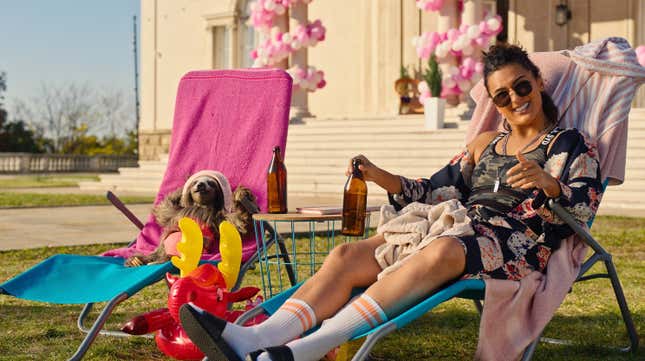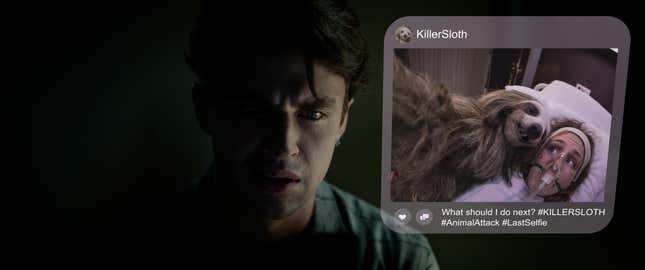How a Sloth Became This Halloween’s Best-Rated Slayer
The writers behind Slotherhouse spoke to Jezebel about the success of their absurdist horror film that's currently scoring some shockingly good reviews.
EntertainmentMovies

Eleven years and 30 million views ago, Kristen Bell was reduced to tears while recalling how her husband surprised her with a sloth for her birthday on the Ellen DeGeneres Show. As so many segments on the defunct daytime program did, the clip—entitled: “Kristen Bell’s Sloth Meltdown”—went viral and an animal beloved for being, well, slow, shot to internet fame really fucking fast. Little did Bell know that such a moment in time would play a part in inspiring this year’s most deranged horror film: Slotherhouse.
Slotherhouse, which released in August and is now streaming on Apple TV and Amazon Prime, follows college senior Emily (Lisa Ambalavanar) as she pines for the role of president of her sorority. The only problem? She’s as kind as her follower count is low and the competition—clout queen and reigning president Brianna (Sydney Craven)—is stiff. Like anyone in pursuit of political supremacy, Emily ultimately determines she needs a gimmick if she’s to win. Naturally, she steals what seems like a sweet sloth off a Joe Exotic-esque animal collector with the hopes that it might be enough to beat the blue-checked and become her sorority’s new mascot. The Sloth, aptly named Alpha, however, has other, homicidal plans, and the horrors that soon consume the house are as ghastly as, well, this.
Sure, Slotherhouse sounds too camp to be real—or worthwhile. The film’s tagline? “Don’t Rush, Die Slowly.” The characters, too, are exaggerated to the point of caricature. Somehow though, Slotherhouse has garnered glowing reviews. The Guardian’s Stuart Heritage called it a “masterpiece”; Variety’s William Earl lauded the “slick” camerawork; and IGN likened it to a “bonkers when-animals-attack midnight treat.” Even PETA, an organization notorious for its many beefs with big budget movies and the bourgeoise, awarded it for promoting wildlife conservation.
Is a sloth wielding a samurai sword against sorority girls ridiculous? Without a doubt. Among the parade of horror releases in 2023—from the second-rate (The Exorcist) to the genuinely stunning (Talk To Me)—Slotherhouse proves it can hang. For an absurdist slasher, it has a lot to say and manages to do so with a sardonic sense of humor and a smart bottom line: Basically, leave nature be or suffer the consequences. The sloth sensationalism, it seems, crawls on.
Over Zoom, writers and producers Bradley Fowler and Cady Lanigan joined Jezebel to discuss their pre-production research (sloth data, if you will), one kill scene that didn’t make the final cut, and how the beta of the animal kingdom became an alpha. This interview has been edited for clarity.
JEZEBEL: First of all, of all endangered animals to be a villain, why a sloth?
Cady Lanigan: At the time that me and Brad went on this creative journey, both of us were looking and seeing sloths everywhere. I mean, Walmart, Target, every major retailer. So there was the zeitgeist of sloth popularity. Then, when we went to do our research for the movie, we were actually able to pinpoint the exact moment that sloths became very popular within culture, which was when Kristen Bell went on The Ellen Show, when her husband Dax Shepard got her the sloth experience for her birthday. Remember that?
Unfortunately.
CL: We always kind of envisioned Alpha as being a character people already really love because it was so familiar to them. We just wanted to make a really cuddly, amazing, fun character for people to interact with that actually had a name. That’s our Alpha.
-

-

-

-

-

-

-

-

-

-

-

-

-

-

-

-

-

-

-

-

-

-

-

-

-

-

-

-

-

-

-

-

-

-

-

-

-

-

-

-









































